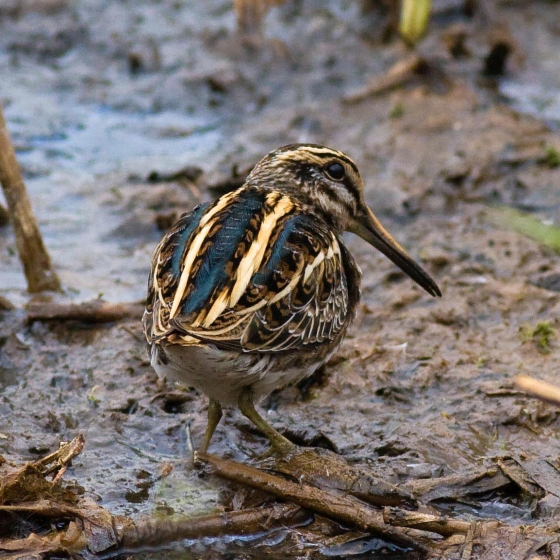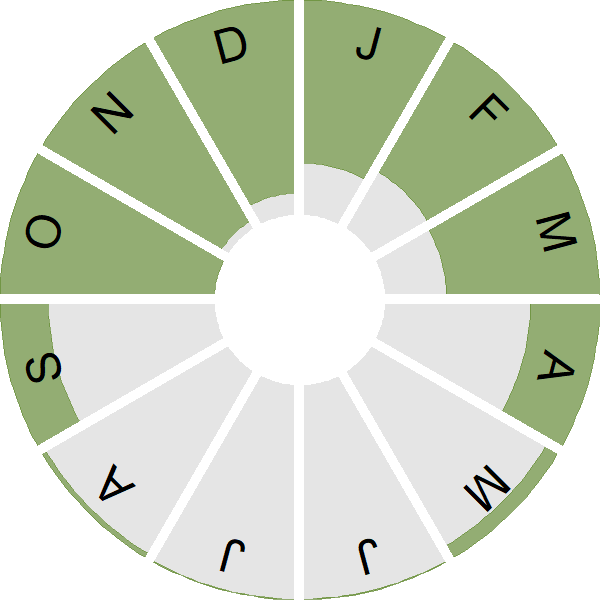Jack Snipe

Introduction
Much smaller than Snipe this winter visitor is seldom seen, its patterned plumage providing perfect camouflage in marshy grassland.
Also called the 'half-snipe' because of its smaller size, this species is a winter visitor, with most birds reported from October through to April. Historically hunted alongside Snipe, it was less popular sport thanks to its habit of flying quickly back to the ground.
Similar to the Common Snipe in behaviour and habits, Jack Snipe is almost certainly commoner than most realise. Only a few WeBS counts manage double figures but atlas projects show records are widely distributed across the UK.

Key Stats
Identification
ID Videos
This section features BTO training videos headlining this species, or featuring it as a potential confusion species.
Common and Jack Snipe
Songs and Calls
Song:
Status and Trends
Conservation Status
Population Change
Jack Snipe is solely a winter visitor and passage migrant in the UK, with no confirmed breeding records Frost et al. 2021]. The trend generated through [WeBS shows large fluctuations, likely due to the small numbers that are recorded each year, despite it having a widespread lowland distribution [Frost et al. 2021].
Distribution
Wintering Jack Snipes are associated with the coastal fringe and damp lowland wetlands and occur throughout the UK. Their secretive nature means they are probably under-recorded in many areas.
Occupied 10-km squares in UK
2007/08–10/11
or view it on Bird Atlas Mapstore.
2008–11
or view it on Bird Atlas Mapstore.
European Distribution Map
Distribution Change
Since the 1981–84 Winter Atlas, the number of occupied 10-km squares has increased by 71% in Britain, but by only 29% in Ireland, a difference that may stem from the greater number of observers in Britain.
Change in occupied 10-km squares in the UK
from 1981–84 to 2007–11
or view it on Bird Atlas Mapstore.
Seasonality
Jack Snipes are winter visitors, present from late September to April.
Weekly pattern of occurrence
The graph shows when the species is present in the UK, with taller bars indicating a higher likelihood of encountering the species in appropriate regions and habitats.

Movement
Britain & Ireland movement
Foreign locations of birds ringed or recovered in Britain & Ireland
Dots show the foreign destinations of birds ringed in Britain & Ireland, and the origins of birds ringed overseas that were subsequently recaptured, resighted or found dead in Britain & Ireland. Dot colours indicate the time of year that the species was present at the location.
- Winter (Nov-Feb)
- Spring (Mar-Apr)
- Summer (May-Jul)
- Autumn (Aug-Oct)

European movements
EuroBirdPortal uses birdwatcher's records, such as those logged in BirdTrack to map the flows of birds as they arrive and depart Europe. See maps for this species here.
The Eurasian-African Migration Atlas shows movements of individual birds ringed or recovered in Europe. See maps for this species here.
Biology
Productivity and Nesting
Nesting timing
Egg measurements
Clutch Size
Fledging
Survival and Longevity
Survival is shown as the proportion of birds surviving from one year to the next and is derived from bird ringing data. It can also be used to estimate how long birds typically live.
View number ringed each year in the Online Ringing Report.
Lifespan
Biometrics
Wing length and body weights are from live birds (source).
Wing length
Body weight
Ring Size
Classification, names and codes
Classification and Codes
- Order: Charadriiformes
- Family: Scolopacidae
- Scientific name: Lymnocryptes minimus
- Authority: Brünnich, 1764
- BTO 2-letter code: JS
- BTO 5-letter code: JACSN
- Euring code number: 5180
Alternate species names
- Catalan: becadell sord
- Czech: slucka malá
- Danish: Enkeltbekkasin
- Dutch: Bokje
- Estonian: mudanepp
- Finnish: jänkäkurppa
- French: Bécassine sourde
- Gaelic: Gobhrag-bheag
- German: Zwergschnepfe
- Hungarian: kis sárszalonka
- Icelandic: Dvergsnípa
- Irish: Naoscach Bhídeach
- Italian: Frullino
- Latvian: vistilbe
- Lithuanian: oželis nykštukas
- Norwegian: Kvartbekkasin
- Polish: bekasik
- Portuguese: narceja-galega
- Slovak: mociarnicka tichá
- Slovenian: puklež
- Spanish: Agachadiza chica
- Swedish: dvärgbeckasin
- Welsh: Gïach Fach
- English folkname(s): St Martin's/Half Snipe, Judcock
More Evidence
More evidence from Conservation Evidence.com
Partners
Citing BirdFacts
If you wish to cite particular content in this page (e.g. a specific value) it is best to use the original sources as linked in the page. For a more general citation of the whole page please use: BTO (20XX) BirdFacts Species: profiles of birds occurring in the United Kingdom. BTO, Thetford (www.bto.org/birdfacts, accessed on xx/xx/xxxx).

